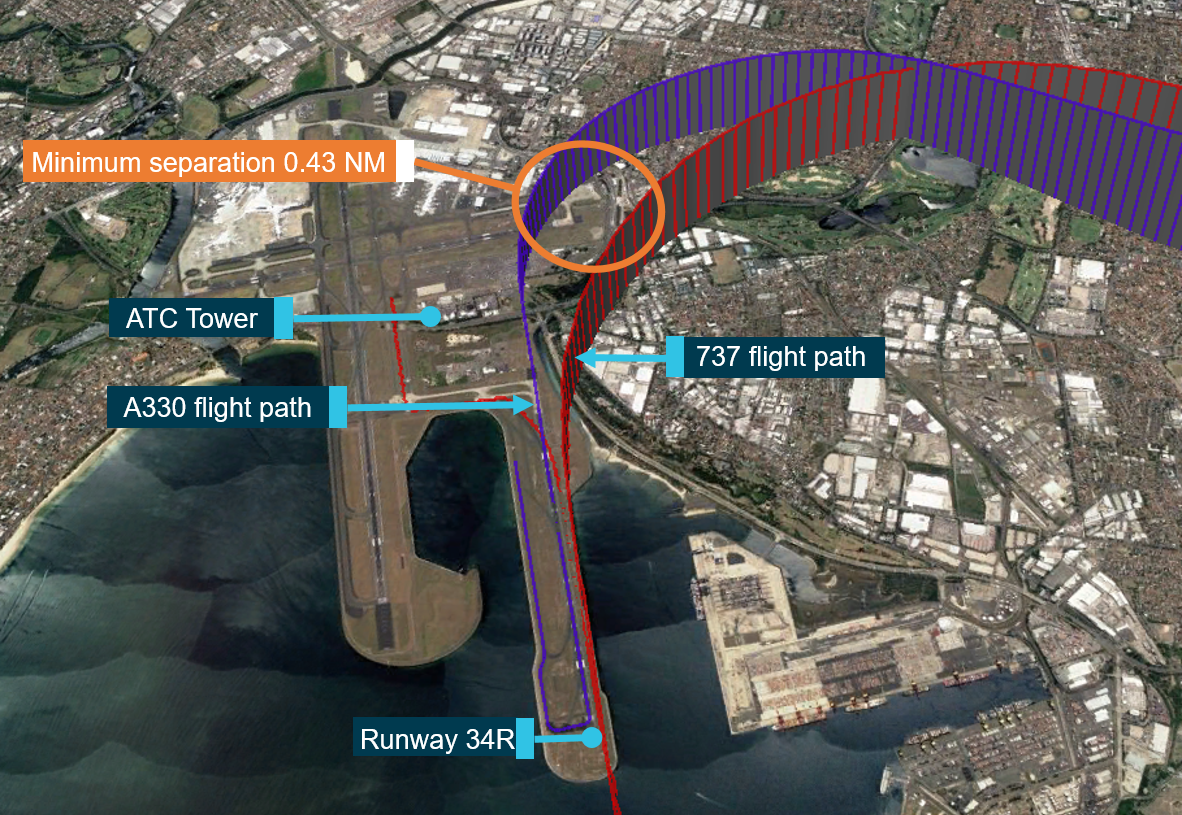
The design of standard instrument approaches and departures, air traffic control and flight crew actions and procedures, and the coding of aircraft flight management system navigation databases are among a number of the factors the ATSB is focusing on as part of the on-going investigation into a loss of separation event near Sydney Airport.
That investigation’s preliminary report, released on 16 January, details that separation between two Qantas aircraft, an Airbus A330-300 and a Boeing 737-800, was reduced to about 0.43 nautical miles (796 metres) laterally and about 500 feet (152 metres) vertically during the incident, which occurred at around 6:30pm on 5 August 2019.
The A330 had been cleared by air traffic control to take-off from Sydney Airport’s runway 34 Right, at the same time that the 737 was on final approach to land on the same runway.
While the A330 was commencing its takeoff run, the air traffic controller with responsibility for managing runway 34 Right, an otherwise experienced controller who was a trainee under supervision for the Aerodrome Controller – East (ADC-E) position, assessed that if the 737 continued to land, there would be insufficient runway spacing between the two aircraft, and so instructed the 737 to conduct a go around.
The preliminary report details that the loss of separation occurred as both aircraft turned to the right.
The preliminary report details that the loss of separation occurred as both aircraft turned to the right, with the A330 turning to the right following a standard instrument departure (SID) from runway 34R (the MARUB 6 SID) and the 737 turning to the right following the missed approach procedure for a GLS (a global navigation satellite system landing system) approach for a landing on runway 34R.
The ADC-E controller, who reported that he had both aircraft in sight, attempted to increase their separation by instructing the 737 to turn further right. As both aircraft converged, the A330 flight crew received a traffic advisory (TA) alert from their aircraft’s airborne collision avoidance system (ACAS).
The A330 first officer, who was pilot flying, then saw the 737 in close proximity and, in response, reduced the aircraft’s angle of bank to reduce the turn towards the 737.
The captain of the A330 radioed to advise the ADC-E controller that their proximity to the 737 was “very close”. The controller then issued an instruction to the A330 flight crew to turn left.
The A330 climbed to 5,000 feet and continued to Melbourne without further incident. The 737 climbed to 3,000 feet and was issued radar vectors for a second approach to runway 34R. It landed without further incident a short time later.
“Preliminary reports outline basic factual information established in the early phase of an investigation. They do not contain findings, identify contributing factors or outline safety issues and actions, which will be detailed in an investigation’s final report,” explained ATSB Director Transport Safety Dr Stuart Godley.
“The ATSB’s on-going investigation into this occurrence will focus on a range of factors including the design and risk assessment of MARUB standard instrument departures and missed approaches from Sydney Airport’s runway 34 Right; air traffic control procedures, controller training and controller actions; flight crew actions and the operator’s procedures for the 737 and A330; coding of flight management system navigation databases; and further analysis of flight data recordings and ATC recordings.”
Read the preliminary report: Close proximity involving Boeing 737, VH-VZO and Airbus A330, VH-EBJ, at Sydney Airport, New South Wales, on 5 August 2019


